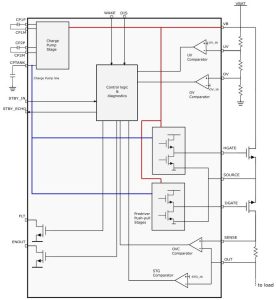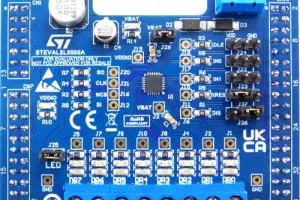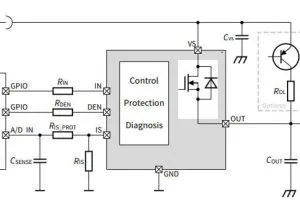
Called STPM801, “the ideal-diode controller drives an external mosfet replacing a Schottky diode conventionally used for reverse-input protection and output-voltage hold-up”, said ST. “When a reverse-voltage event occurs, in case of faults like power source failure, brown-out or input short-circuit, turning off the mosfet blocks the associated reverse-current transients.”
The ideal diode controller is wrapped around the lower mosfet in the diagram, and a typical use would be as part of an active OR-ing circuit that switches between a main and back-up batteries to ensure an uninterrupted power supply to safety-critical equipment such as autonomous driving and driver assistance systems.
Above positive rail gate bias for mosfets comes from an integrated charge-pump.
The integrated hot-swap controller drives the second external mosfet (upper one in the diagram) to protect loads during hot-swap events.
Gate pull-up is via a constant current source, allowing a soft-start function to be implemented using a capacitor connected to that gate to limit in-rush current. A hard pull-down quickly discharges the capacitor to avoid turn-off problems.
Over-voltage and under-voltage pins cut off the output whenever the input voltage is outside specified thresholds.
Other protections include a power input that can withstand -65V faults on the bus. Quiescent current during normal operation can be <50μA if the wake pad is held low.
Protection features and monitoring are suitable for applications that meet functional safety requirements up to ASIL D according to ISO 26262, said ST.
Packaging is a 5 x 5mm VFQFN-32.
 Electronics Weekly
Electronics Weekly



